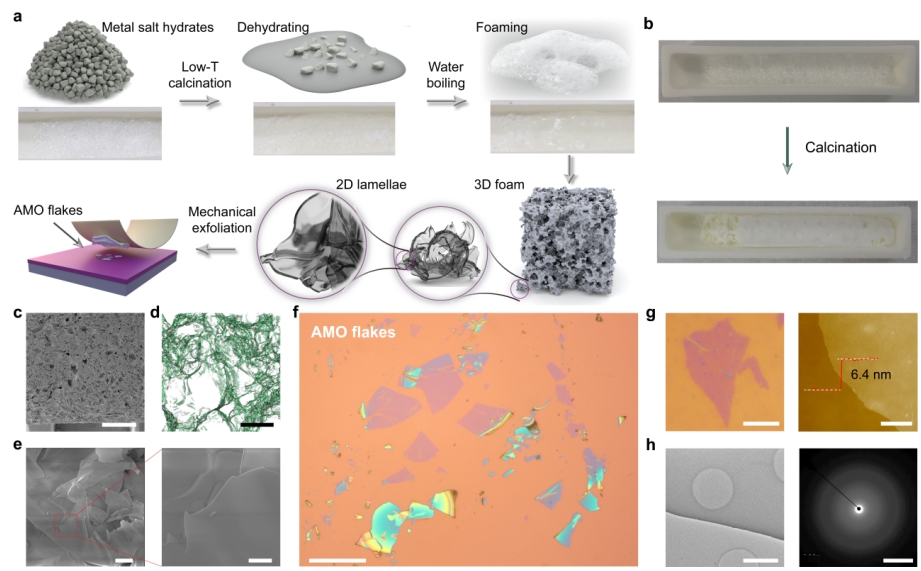In 2004, Dr. Andre K. Geim and Dr. Konstantin S. Novoselov used mechanical exfoliation to obtain single-atomic-layer graphene, sparking two decades of research on two-dimensional (2D) materials. While mechanical exfoliation has become a common method for preparing 2D materials, it primarily applies to intrinsically layered crystals. For non-layered materials with continuous chemical bonding in z-direction, there has been no general method for mechanical thinning. As early as the 1980s, Dr. John W. Hutchinson and Dr. Zhigang Suo theoretically studied crack propagation mechanisms parallel to the surfaceandinterface in brittle materials, offering hope for breaking the mechanical exfoliation limitation on weak “interlayer” interactions.
Recently, Prof. LeiLiu’s group at School of Materials Science and Engineering, Peking University, developed a foaming-exfoliation method (authorized patent: CN 114853038 B) for the general preparation of a variety of 2D amorphous metal oxides(AMOs) with thicknesses less than ten nanometers, including uni-and multi-component oxides of post-transitionmetals/transition metals/lanthanides. By combining thermal decomposition of metal salts with water-assisted foaming technology, they obtained lamellae with large aspect ratios.Independent, self-supporting 2D flakes were then obtained using tape exfoliation. Further theoreticalstudiesindicated that, during mechanical exfoliation, bending moments introduced concentrated shear stress at pre-existing geometricalflaws, leading to crack formation. These cracks propagatedlongitudinally, achieving thickness reduction and producing thinner 2D flakes.

Fig.1 Mechanical exfoliation of AMOs. (a) Schematic of the process; (b-h) Structural characterization.
Further studies found that AMO scouldbe transferred non-destructively and used as building blocks for van der Waals integration with 2D semiconductors, forming 3D-2D heterojunctions. They achieved a subthreshold swing of 70 mV dec⁻¹ and a hysteresis of 2.7 mV (MV cm⁻¹)⁻¹.

Fig.2Electrical measurements of AMOs. (a-c) Van der Waals integration; (d-g) Device applications.
This research achieved general mechanical exfoliation of AMOs and expanded their application in 2D van der Waals heterojunction electrical devices. It provides a platform for studying the intrinsic properties of ultrathin metal oxides without substrate limitations and offers new ideas and methods for 2D functional devices based on metal oxides.
Dr. Ruijie Li from School of MaterialsScience and Engineering, Peking University, PhD student Zhixin Yao from Taiyuan University of Technology, PhD student Zhenjiang Li from School of Materials Science and Engineering, Peking University, PhD students Lei Liao, Huacong Sun from Institute of Physics, Chinese Academy of Sciences, and postdoctoral fellow Chaonan Cong from College of Engineering, Peking Universityare co-first authors of this paper. Associate Professor Lei Liu from School of Materials Science and Engineering, Peking University, is the corresponding author. Key collaborators includeacademician EngeWangand Professor KaihuiLiufrom School of Physics,Peking University, academician YueZhangand Professor Qingliang Liao from University of Science and Technology Beijing, academician Hong-JunGaoand researcher Lihong Bao from Institute of Physics, Chinese Academy of Sciences, Professor Xiaoding Wei from College of Engineering, Peking University, Professor Jiawang Hong and Associate Professor Xueyun Wang from Beijing Institute of Technology, and ProfessorJunjie Guo from Taiyuan University of Technology.
This work was supported by the Ministry of Science and Technology, theNational Natural Science Foundation of China, and the Outstanding Young Scientist Program of Beijing.
Original link:https://www.nature.com/articles/s44160-024-00657-8